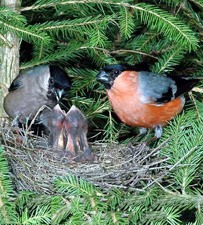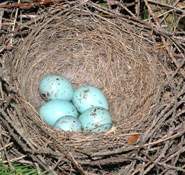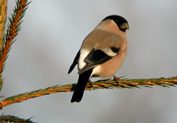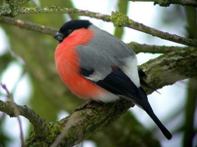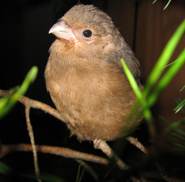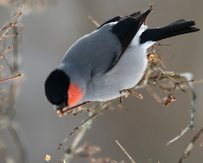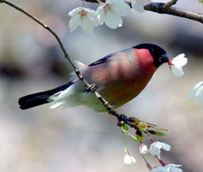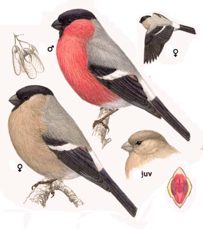|
||||||||||||||
Pyrrhula pyrrhula |
The bright red underparts of a male Bullfinch can provide a rare splash of colour on a grey winter's day but their habit of destroying fruit-tree buds means they are not universally popular. Bullfinches are big, fat finches which can be most easily identified by their neat, jet black caps or their obvious square white rumps, as if the base of the tail has been wrapped in white bandage. Females are browner than males, lacking the red front and grey back. Juveniles lack the black cap but can still be told by their fat, bull-necked appearance and short but very deep black bill, as well as the conclusive white rump.
Bullfinches are in serious trouble in Britain, with the population down by 62 per cent in 35 years. The UK Bullfinch population has been in decline since the mid-1970s, following a period of relative stability. The decline was initially rapid, but has been shallower since the early 1980s. Nevertheless, the CES and BBS both suggest that the decline is continuing, at least in southern Britain. The demographic mechanism remains unclear (Siriwardena et al. 1999, 2000b), although agricultural intensification is suspected to have played a part. CES data indicate that productivity has increased over the last decade, and nest failure rates at the chick stage (15 days) have fallen from 37% to 21%.
|
Physical DescriptionThe Bullfinch is a small bird, about six inches in length. The male has a distinctive black cap, rose-red underparts, and white rump. The female and juveniles are more pinkish-grey in color. ReproductionBullfinches construct nests containing fine twigs with moss and lichen intertwined and a lining of black roots and shrubs. Nests are usually placed only a few feet above ground. There are sometimes up to three clutches of 4-5 eggs laid during the season, which spans early May to mid-July. Chicks hatch out in about two weeks and are fed a mixture of seeds and insects. The male Bullfinch do not helps the female incubate the eggs, but he feeds her while she sits on the nest. He later assists the female in collecting food for the young and feeds them just as well. BehaviorThe Bullfinch can be seen throughout the year in pairs or in small family parties. In the spring, they also may form flocks of about fifty (rarely over one hundred) birds. Bullfinches generally are shy, perching within the cover of trees, not often on the ground. It reveals its presence through its penetrating low whistle "piping" song. Food HabitsBullfinches feed primarily on buds and seeds. The buds from fruit trees, especially woodland trees, are eaten exclusively in the spring. A bullfinch feeds on the buds by landing on the tip of a branch and slowly moving towards the trunk, stripping the bud as it goes. However, it is only when supplies of seeds remaining from the previous summer and autumn diminish that bullfinches attack buds. In deciduous woods, bullfinches demonstrate a preference for the seeds of dock, nettles, privet, bramble, birch and ash. These seeds are the main food supply until buds begin to develop. Economic Importance for Humans: NegativeBullfinches inflict serious damage on orchards by feeding on the buds of fruit trees. This has been a serious problem, especially in south-east England, where orchards capable of yielding several tons of fruit have been stripped by bullfinches so efficiently that only a few pounds could be harvested. Conservation StatusOnly 1/3 of all clutches in woodland and 2/3 of those in farmlands live to adulthood. The remaining are eaten by predators, which are mainly jays, magpies, stoats, and weasels. The Bullfinch has been persecuted in England since the 16th century. Nevertheless, numbers continue increasing and more efficient ways of killing them are constantly being sought.
|
190 000 territories in Britain, across much of the country with another 100 000 in Ireland. 2-4 million breeding pairs widespread across Europe but becoming rare in the south where it is confined to the highlands of Italy and northern Spain. |
 |
